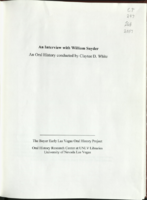Search the Special Collections and Archives Portal
Search Results

Transcript of interview with Bill Snyder by Claytee White, November 21, 2008
Date
Archival Collection
Description
In 1978 Bill Snyder came Las Vegas for a heavyweight championship fight between his homeboy, Larry Holmes and Ken Norton. During that visit, he saw cranes dotting the cityscape so he returned home and proposed that the family move across country and settle in the desert. His wife, Joy, gave him a year. And as they say, the rest is history. And what am amazing history it is. In this interview, Bill Snyder talks about his life from its beginning in Easton, Pennsylvania, where he discovered the challenge of architecture first by perusing books in the library and then by hands-on construction experience. But his love of art built the foundation to this treasured craft that has allowed him to design homes, office buildings, airport terminals and the McCaw School of Mines on the campus of McCaw Elementary School in Henderson, NV. The projects that Mr. Snyder seems to prize most are those that include the imagination of children. The people who shaped his life are introduced and the impact of his military training is wonderfully expressed. His connection with young people is paramount throughout the oral history that is beautifully documented with images of many of the projects that displayed children's art in an exciting way. Bill and Joy are the parents of two sons. Dana age 36, lives with his wife Christine in Hollywood, California, and works as a voice actor best known for his role as Master Shake on the cartoon Aqua Teen Hunger Force. Their younger son, Mike age 31, owns The Krate, a clothing, music, and art shop in Santa Cruz, California, where he lives with his wife Mandy and daughter Maya. A husband, father, sports car enthusiast, runner, thinker and lover of teaching and trusting young people, Bill Snyder is a brilliant architect and manager of people. He is dyslectic and never expected a school to be named in his honor but the William E. Snyder Elementary School was dedicated in 2001 with overwhelming community support. One of his current goals is to dream an architectural project that rivals the McCaw School of Mines for his own school. I trust that you will learn to love architecture in a different and very profound way as you read this interview just as I did during my conversation with Bill.
Text

Transcript of interview with Joel Bergman by Stefani Evans and Claytee D. White, August 03, 2016
Date
Archival Collection
Description
Born in 1936, architect Joel Bergman spent his childhood in Venice, California, the son of Edythe Klein and Harry Bergman, a baker who later turned to dealing in scrap metal. The award-winning designer of such Las Vegas projects as the International Hotel, the MGM Grand Hotel (later Bally's), additions to the Riviera Hotel and the Golden Nugget downtown, the Mirage, Treasure Island, Paris Casino Resort, Caesars Palace, Trump International Hotel and Tower, the Signature at MGM Grand, Rhumbar, Gilley's at Treasure Island, and the Tropicana Hotel and Casino first arrived in Las Vegas in 1968 to work on the International Hotel. In this interview, Bergman discusses his architectural career, which began with his graduation in architecture from the University of Southern California; he also discusses his work with Martin Stern, his sixteen years with Steve Wynn, and the formation of his own architectural firm, Bergman Walls and Associates. Throughout, he pays tribute to the three mentors who had the greatest influence on his work—USC architecture professor Carleton Winslow, architect Berton Severson, and client Steve Wynn—and the ways they visualized people moving through space. He acknowledges other professionals whose work he admired and talks about his wives Marlene Federman, Terrie Colston, Maria Nicolini, and Valentina Bogdanova as well as his children and stepchildren. Joel David Bergman passed away August 24, 2016, three weeks after he gave this interview.
Text
Brian Block oral history interview
Identifier
Abstract
Oral history interview with Brian Block conducted by Diane Spero on February 27, 1979 for the Ralph Roske Oral History Project on Early Las Vegas. Block discusses the construction business, community planning, architectural design, and his personal feelings in regard to the development of the Las Vegas, Nevada area. Block also discusses legalized gambling, politics, mass transit problems, and other social and environmental changes in Nevada.
Archival Collection
Dave Pugsley oral history interview
Identifier
Abstract
Oral history interview with Dave Pugsley conducted by Stefani Evans and Claytee D. White on October 21, 2016 for the Building Las Vegas Oral History Project. In this interview, Pugsley discusses his early life in Salt Lake City, Utah and moving to Las Vegas, Nevada in 1963. He talks about his father’s employment with Young Electric Sign Company (YESCO) and the Nevada Test Site. Pugsley recalls his initial interest in architecture, drawing a construction document for the Home Builders Association while in high school, and attending the University of Utah for a degree in architecture. Pugsley then talks about building planning for schools in Clark County, the process of designing a school, and the challenges that arise. Lastly, Pugsley discusses building planning for Lied Library and the William S. Boyd School of Law at the University of Nevada, Las Vegas (UNLV).
Archival Collection

Joy Rineer oral history interview: transcript
Date
Archival Collection
Description
Oral history interview with Joy Rineer conducted by Claytee D. White on December 07, 2017 for the Remembering 1 October Oral History Project. In this interview, Rineer discusses her upbringing in Las Vegas, Nevada. She describes her career as an architect, designing the Resilience Center for those affected by the 1 October shooting, and the city’s response to the shooting. Later, Rineer describes helping the grief-stricken city through architecture, establishing the Leadership Las Vegas program, and organizing blood drives. Lastly, Rineer discusses the changes in Las Vegas after the tragedy.
Text
Jane Fielden, Laura Jane Fielden Spina, and Bob Fielden oral history interviews
Identifier
Abstract
Oral history interviews with Jane Fielden, Laura Jane Fielden Spina, and Bob Fielden conducted by Claytee D. White and Stefani Evans on May 27, 2016 and June 27, 2016 for the Building Las Vegas Oral History Project. In the first interview, Jane and Robert discuss their upbringing and early interest in architecture. They talk about arriving to Las Vegas, Nevada in 1964, and forming their construction company RAFI Architecture and Design. They talk about changes in the Las Vegas economic structure during the late 1970s, and projects for the library district, the University of Nevada, Las Vegas (UNLV), and Maryland Parkway. In the second interview, Laura Jane discusses her upbringing in Las Vegas, Nevada. She talks about becoming an interior designer and becoming president of RAFI Architecture and Design. Lastly, Jane, Laura, and Bob discuss improving the quality of lives through architecture.
Archival Collection
Agnes and Emory Lockette oral history interview
Identifier
Abstract
Oral history interview with Agnes and Emory Lockette conducted by Claytee D. White on March 11, 2005 for the Boyer Early Las Vegas Oral History Project. In this interview, Emory discusses his education in architectural and structural engineering. Agnes describes her education in early childhood education, teaching in the Westside and at the University of Nevada, Las Vegas (UNLV). Emory then recalls his employment at the Bureau of Reclamation. Lastly, the two share their active involvement with the Boulder City, Nevada community.
Archival Collection

Transcript of interview with DeRuyter Butler by Stefani Evans and Claytee White, September 15, 2016
Date
Archival Collection
Description
Not many sixteen-year-olds assume the roles of father and mother to three younger siblings (one an infant), graduate from high school on time, and earn a full-ride scholarship (plus a loan) to a prestigious university. One such sixteen-year-old was Washington, D.C., native DeRuyter O. Butler, Executive Vice President of Architecture, Butler/Ashworth Architects, Ltd., LLC, and formerly Executive Vice President, Architecture, of Wynn Design & Development, LLC, and Director of Architecture, Atlandia Design & Furnishings, Inc. Determined to do right on behalf of his siblings and himself, Butler recruited his grandmother and enrolled in Catholic University, earning his B.S. in Architecture in 1977 while working overtime at the U.S. Post Office, buying a house in Maryland, and supporting his family. His first professional job in Philadelphia required him to rethink his living arrangements. Partnering with his sister, who assumed childcare duties during the week in Maryland, Butler lived in New Jersey during the week and commuted to Maryland on the weekends. After four years in that position and a short stint of being unemployed, in 1982 he became a draftsperson for Steve Wynn's Atlandia Design in Atlantic City. After he had worked with architects Joel Bergman and Paul Steelman in Atlantic City for four years, Wynn moved Atlandia Design to Las Vegas. Butler followed in 1986, bringing with him his grandmother and his youngest brother. In this interview, Butler discusses his unusual career path; the challenges of responding to and anticipating entertainment and recreation market trends; Wynn's insistence on always striving for "better"; and the importance of concealing service infrastructure in order to create the ultimate guest experience. He emphasizes Wynn's leadership in the gaming industry and with Clark County and the City of Las Vegas. He speaks to lessons learned from designing The Mirage, Bellagio, the Wynn, Wynn Palace, and Encore. Finally, he describes real-world limitations to building such as drought and historic water rights; traffic patterns, ride-hailing companies, and parking restrictions, and flight patterns and building heights.
Text
John Klai II oral history interview
Identifier
Abstract
Oral history interview with John Klai II conducted by Stefani Evans and Claytee D. White on August 15, 2016 for the Building Las Vegas Oral History Project. In this interview, Klai discusses his upbringing in North Dakota. He recalls attending the University of North Dakota and transferring to North Dakota State University to study architecture. Klai talks about moving to Las Vegas, Nevada in the late 1970s, and his employment at Marnell Corrao Associates. Klai describes founding an architecture firm, Klai Juba Wald Architects + Interiors in 1995, and talks about the firms involvement with the architecture program at the University of Nevada, Las Vegas (UNLV). Lastly, Klai discusses sponsoring a lecture series at UNLV, and awarding scholarships to UNLV architecture students.
Archival Collection
Edward Vance oral history interview
Identifier
Abstract
Oral history interview with Edward Vance conducted by Stefani Evans and Claytee D. White on September 16, 2016 for the Building Las Vegas Oral History Project. In this interview, Vance discusses his upbringing in Redfield, South Dakota. He talks about his move to Las Vegas, Nevada in 1987, teaching architectural drawing at the University of Nevada, Las Vegas (UNLV), and the first projects he worked on in Las Vegas. Vance describes the financial aspects of architecture, the challenges of meeting building regulations, and benefits that new buildings bring to city life. Lastly, Vance discusses founding Ed Vance & Associates Architects.
Archival Collection
